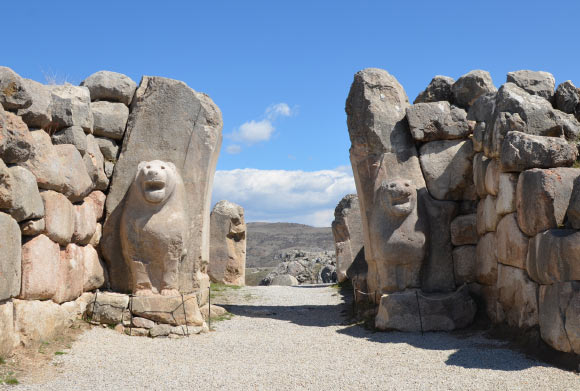The Hittites were one of the great powers in the ancient world across almost five centuries, between 1650 and 1200 BCE, with an empire centered in Anatolia — a region that includes much of modern Turkey — with political and socioeconomic interconnections throughout the ancient Near East and Eastern Mediterranean. In new research, scientists analyzed ring width and stable isotope records from ancient juniper trees recovered from archaeological excavations at the site of Gordion in central Anatolia, about 230 km west of the Hittite capital Hattusa. They identified an unusually severe continuous dry period from around 1198 to 1196 BCE.
The Lion Gate flanked by two towers in Hattusa, capital of the Hittite Empire. Image credit: Carole Raddato / CC BY-SA 2.0.
The vast Hittite Kingdom and subsequently Empire, based in central Anatolia, Turkey, with its capital at Hattusa, is recognized from both rich archaeological remains and textual sources as one of the major Old World powers of the Eastern Mediterranean and Near East between 1650 and 1200 BCE.
At its apex, the Hittites maintained control over central, southern and southeastern Anatolia, the northern Levant and northern Syria, with almost all of Anatolia being under the Hittite sphere of influence.
During this time, the Hittite Empire vied with the Egyptian Empire for sociopolitical dominance in the Near East, a struggle that culminated in the largest battle of the era at Kadesh in Syria in the early 13th century BCE.
Around or shortly after 1200 BCE, the Hittite Empire and central administrative system collapsed in a great realignment that reverberated around the Near East.
The reign of the last known king, Suppiluliuma II, began around 1207 BCE and included claimed victories against several intra-Anatolian rivals (Wiyanawanda, Masa, Lukka and Ikkuna) and Alashiya (Cyprus) in sea and land battles, but no further Hittite rulers were recorded subsequently.
An inscription of the Egyptian ruler Ramesses III — dated to 1188 or 1177 BCE, depending on selection and debate in Egyptian history and chronology — lists the Hittites among those swept away by the ‘Sea Peoples’ before they attacked Egypt.
The end of settlement at the Hittite capital of Hattusa itself has been a key topic of historical scrutiny.
Long considered a victim of attack, whether by the Sea Peoples or local Anatolian raiders, archaeological investigations now indicate that the city was abandoned and emptied by the royal administration and only later burnt.
Hattusa was the political and core religious venue of the Hittite gods and kings for centuries, and the reasons for its abandonment remain unclear.

The fortifications of Hattusa, along with the Lions’ Gate, the Royal Gate and the Yazilikaya rupestral ensemble and its sculptured friezes, represent unique artistic achievements. Image credit: Murat Özsoy / CC BY-SA 4.0.
To find an explanation, Cornell University’s Professor Sturt Manning and colleagues juniper (Juniperus excelsa and Juniperus foetidissima) timbers recovered from the Midas Mound Tumulus at Gordion, a human-made 53-m-tall structure located west of Ankara, Turkey.
The mound contains a wooden structure believed to be a burial chamber for a relative of King Midas, possibly his father.
The researchers looked at the patterns of tree-ring growth, with unusually narrow rings likely indicating dry conditions, in conjunction with changes in the ratio of carbon-12 to carbon-13 recorded in the rings, which indicate the tree’s response to the availability of moisture.
Their analysis finds a general shift to drier conditions from the later 13th into the 12th century BCE, and they peg a dramatic continuous period of severe dryness to approximately 1198-96 BCE, plus or minus three years, which matches the timeline of the Hittite’s disappearance.
“We have two complementary sets of evidence,” Professor Manning said.
“The tree-ring widths indicate something really unusual is going on, and because it’s very narrow rings, that means the tree is struggling to stay alive.”
“In a semi-arid environment, the only plausible reason that’s happening is because there’s little water, therefore it’s a drought, and this one is particularly serious for three consecutive years.”
“Critically, the stable isotope evidence extracted from the tree-rings confirms this hypothesis, and we can establish a consistent pattern despite this all being over 3,150 years ago.”
At three consecutive years of drought, hundreds of thousands of people, including the enormous Hittite army, would face famine, even starvation.
The tax base would crumble, as would the government. Survivors would be forced to migrate, an early example of the inequality of climate change.
Severe climate events may not have been the sole reason for the Hittite Empire’s collapse, and not all of the ancient Near East suffered crises at the time. But this particular stretch of drought may have been a tipping point, at least for the Hittites.
“Situations where you get prolonged, really extreme events like this for two or three years are the ones that can undo even well-organized, resilient societies,” Professor Manning said.
“That finding has particular relevance today, when global populations are reckoning with catastrophic climate change and a warming planet.”
“We may be approaching our own breaking point,” he added.
“We have a range of things we can cope with, but as we are stretched too far beyond that, we’ll hit a point where our adaptative capacities are no longer matched against what we’re facing.”
The research is described in a paper published in the journal Nature.
_____
S.W. Manning et al. Severe multi-year drought coincident with Hittite collapse around 1198-1196 BC. Nature, published online February 8, 2023; doi: 10.1038/s41586-022-05693-y




